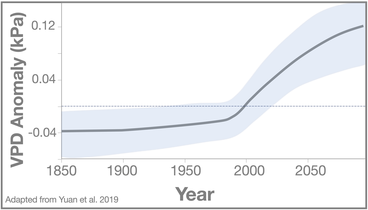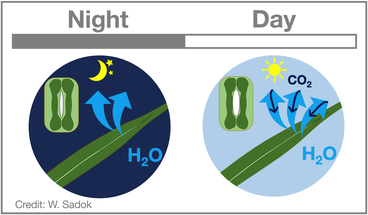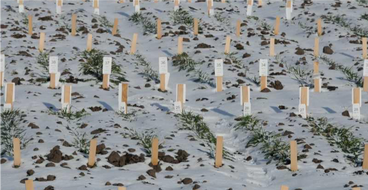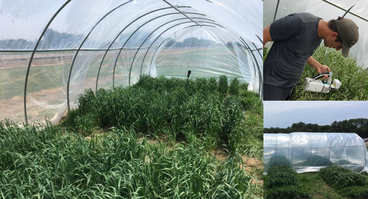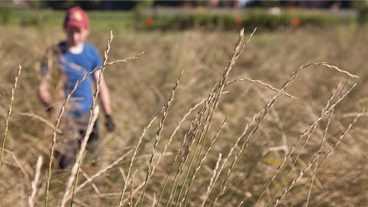Crop responses to global increase in evaporative demand: opportunities for improving yields in a dryer world
Global increases in vapor pressure deficit (VPD) or 'atmospheric drought' are driving yield decreases in several key production environments across the globe. One way to mitigate such penalties is to design crop cultivars that either conserve water as VPD increases (drought-prone environments) or overcome unnecessary restrictions to crop water use under high VPD (well-watered environments). However, the genetic basis of such traits and where to precisely deploy them (geographically) remains unknown, resulting in a major bottlenecks to improving yields under climate change. In this research, we address this challenge by combining eco-physiological dissection, physiological phenotyping of mapping populations and crop simulation modeling.
Representative publications:
Tamang, B.G.‡, D.M. Monnens‡, J.R. López‡, J.A. Anderson, B.J. Steffenson and W. Sadok. 2022. The genetic basis of transpiration sensitivity to vapor pressure deficit in wheat. Physiologia Plantarum, 174 (5), e13752.
López‡, J.R, D.A. Way and W. Sadok. 2021. Systemic effects of rising atmospheric vapor pressure deficit on plant physiology and productivity. Global Change Biology, 27 (9), 1704–1720.
Sadok, W., Schoppach‡, M.E. Ghanem, C. Zucca, and T.R. Sinclair. 2019. Wheat drought-tolerance to enhance food security in Tunisia, birthplace of the Arab Spring. European Journal of Agronomy, 107: 1–9.
Nocturnal transpiration in crops: magnitude, genetic variability and response to nighttime warming
Global warming is taking place more aggressively during the nighttime. In fact, nighttime temperatures are rising at a rate that is 1.4 times that of daytime temperatures. Such warming is likely to be associated with increases in nighttime evaporative demand, which induces seemingly 'wasteful' nighttime water losses through transpiration. Because no photosynthesis occurs during the night, high nocturnal transpiration could be aggravate the severity of drought events. The goal of this research is to quantify the extent of nighttime transpiration in crops, its mechanistic basis and its relationship to yield under various water availability regimes.
Representative publications:
Sadok, W. and S.V.K. Jagadish. 2020. The hidden costs of nighttime warming on yields. Trends in Plant Science, 25 (7), 644–651.
Schoppach‡, R, T.R. Sinclair and W. Sadok. 2020. Sleep tight and wake-up early: nocturnal transpiration traits to increase wheat drought tolerance in a Mediterranean environment. Functional Plant Biology, 47 (12): 1117–1127.
Sadok, W, J.R. López‡, Y. Zhang‡, B.G. Tamang‡, and G. Muehlbauer. 2020. Sheathing the blade: significant contribution of sheaths to daytime and nighttime gas exchange in a grass crop. Plant, Cell and Environment, 43 (8): 1844–1861.
The physiological basis of freezing tolerance in winter crops grown in northern climates
Enhancing winter hardiness of emerging Minnesota-grown crops such as barley and pea is critical to diversifying cropping systems of the upper Midwest and to sustain vibrant local industries such as plant protein- and beer-making. So far, phenotypic selection via survival rates is the only viable approach to breeding. The goals of this project are to identify ecophysiological traits that are associated with freezing survival and to use such traits to develop a phenotyping pipeline to support barley and winter pea breeding programs for enhanced winterhardiness. Photo Credit: Brian Steffenson.
Representative publications:
W Sadok, JJ Wiersma, BJ Steffenson, SS Snapp and KP Smith. 2022. Improving winter barley adaptation to freezing and heat stresses in the US Midwest: bottlenecks and opportunities. Field Crops Research, 286, 108635.
Tamang, B.G.‡, J.R. López‡, E. McCoy‡, A. Haaning, A. Sallam, B.J. Steffenson, G. J. Muehlbauer, K.P. Smith and W. Sadok. 2022. Association between xylem vasculature size and freezing survival in winter barley. Journal of Agronomy and Crop Science, 208 (3), 362–372.
Wiering, N.P., C. Flavin, C.C. Sheaffer, G.C. Heineck, W. Sadok, and N.J. Ehlke. 2018. Winter hardiness and freezing tolerance in a hairy vetch collection. Crop Science, 58 (4): 1594–1604.
The physiological and genetic bases of heat stress tolerance in oat
Minnesota is also subject to heat stress in the summer. Evidence shows that historical increases in temperature during the summer drove yield decreases of locally grown oat, which prompted growers to look for more profitable crops such as corn and soybean. This project aims at identifying oat heat stress tolerance traits and genetic markers that will be leveraged in an ongoing breeding program to release more resilient oat varieties towards heat stress events that are expected to increase in frequency and intensity in Minnesota. Photo Credit: José López.
Representative publications:
López, J.R.‡, B.G. Tamang‡, D.M. Monnens‡, K.P. Smith and W. Sadok. 2022. Canopy cooling traits associated with yield performance in heat-stressed oat. European Journal of Agronomy, 139, 126555.
Sadok, W., J.R. López‡ and K.P. Smith. 2021. Transpiration increases under high‐temperature stress: Potential mechanisms, trade‐offs and prospects for crop resilience in a warming world. Plant, Cell and Environment, 44 (7), 2102–2116.
Parsing the environmental and physiological drivers of inter-annual yield depression in intermediate wheatgrass
Intermediate wheatgrass is a new perennial grain crop that is currently being domesticated across Minnesota and the U.S. This crop holds promise thanks to its numerous ecosystem services in additional to its ability to produce food-grade seeds. However, a challenge with this new crop is that it exhibit a large yield depression particularly following the first year, which may decrease its attractiveness to risk-averse farmers. The goal of this program is to identify the environmental and physiological drivers of this phenomenon, as an approach to inform breeding and agronomics programs to enable minimizing this interannual yield decline. Photo Credit: University of Minnesota.
Funding sources: Minnesota Wheat Research & Promotion Council, Minnesota Soybean Research & Promotion Council, Minnesota Department of Agriculture, Forever Green Initiative, University of Minnesota, NSF/CRDF, USDA-NIFA
